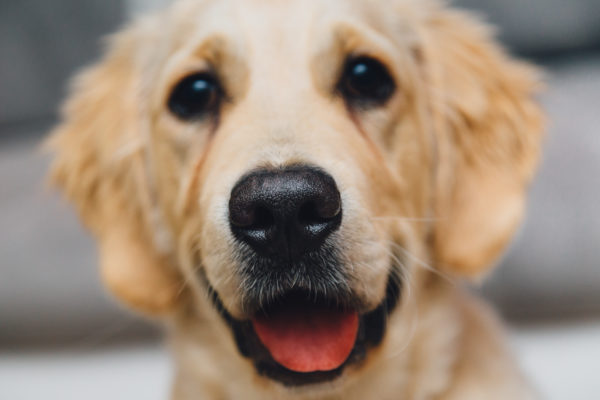What’s a dog going to do?

Volunteer Gareth gives us a special peek into his life with Domino.
A week ago, the dog trainer came to our house, put Domino and the two bags I’d packed with all his possessions into her car, and drove him to the house where he’ll start his working life as an Accredited Hearing Dog. He’s been my shadow for the last 20 months, but it’s likely I’ll not see him again. (My eyes and ears have not caught up with reality, and I often glimpse or hear his ghost still trying to shadow me.)
So, my fallible ears hear you cry, what’s the difference between an accredited Hearing Dog, a Sound Support Dog and a Confidence and Companion Dog, to name just three of the roles the charity’s dogs might eventually fill? Here’s a brief, unofficial explanation. (Unofficial, since I’m not employed by the charity; I’m just lucky enough to look after some of their dogs – well, two, so far – while they go through the last stages of their training.)
An accredited Hearing Dog is the most visible of these working dogs: they wear the burgundy jacket (or in Domino’s case a bandana – more on that later); they go into shops, into people’s workplaces or schools. Everywhere the recipient might need assistance with hearing and communicating, they’ll be there alerting them to the sounds and events they might otherwise miss. And, of course, just by being dogs, they’ll provide comfort, company and a bridge to the wider world: any dog walker knows how people talk to you far more when you’re with your dog. More of the dogs bred and trained by Hearing Dogs for Deaf People are given this role than any other role.
A bit more than a third of the number who become accredited Hearing Dogs take on the role of Sound Support Dog. These dogs are equally as well trained in sound work. They alert their partners to the doorbell, telephone alerts, alarm clocks, smoke alarms, and potentially a whole host of other sounds. Outside the house, however, they don’t wear the burgundy jacket; they are then merely (!) a pet dog.
Confidence and Companion dogs are, of course, well-trained dogs, but they are placed with people who, for whatever reason, do not need to be alerted to sounds, but who benefit enormously from, well, the confidence and companionship that a dog can bring.
The whole process of deciding the career of each dog seems more analogous to a match-making service than a job interview. The recipients all have different needs – some, for instance, might only need help around the house – and the dogs have individual strengths and characters. These strengths and characters are built upon and developed throughout the dog’s training, and a picture is built up of where the dog might be happiest and most useful.
Domino, for instance, is incredibly affectionate and good-natured, and wants to be with his partner all the time. Although confident, he’s probably not suited to a very noisy urban environment, where he might feel a little overstimulated, and he’s never got completely used to wearing the Hearing Dog jacket; he seems to feel very constricted in it, which is why he’ll wear the HD bandana when out and about. When off lead, he loves playing with other dogs and scavenging for food (he seems to sincerely believe that all food has his name on it), but he’s gentle on lead, a very desirable characteristic in a Hearing Dog, since many of the recipients are elderly and/or might have balance issues.
Once Domino’s proficiency at sound work was up to standard, the trainer started the matchmaking process – a similar picture of the needs and wants of the recipients having been built up from the time of their application onwards – and, hopefully, his perfect match was found.
If I’m lucky, we’ll get another dog in the latter stages of its training soon. I’m confident this dog will chase away the ghosts of Domino I’m seeing and hearing, leaving me with the amazing memories of Domino’s time here, and creating even more great day-to-day experiences. I’m also confident this dog will eventually leave, in whatever role they’re best suited, to change someone else’s life for the better.
Thank you to volunteer, Gareth for sharing this insight into his life with Domino.
We are actively looking for volunteers to help us care for and train our gorgeous puppies and dogs in their own home. If you are interested in finding out more, here’s the link and of course, you can get in touch with me if you have any questions.